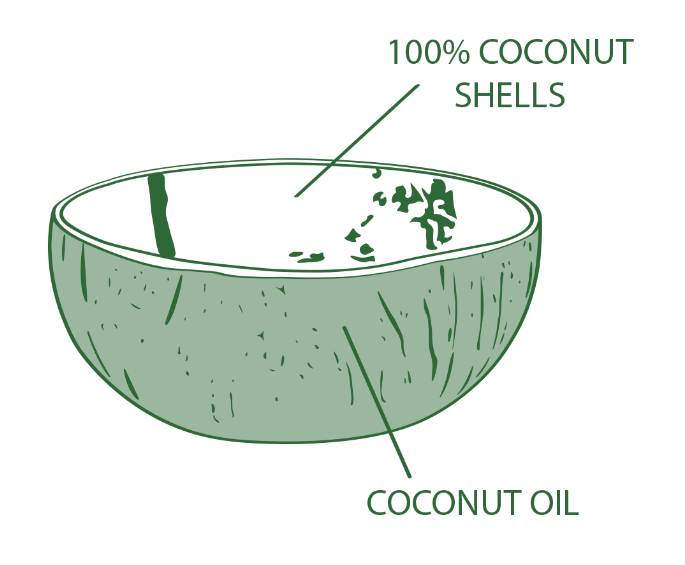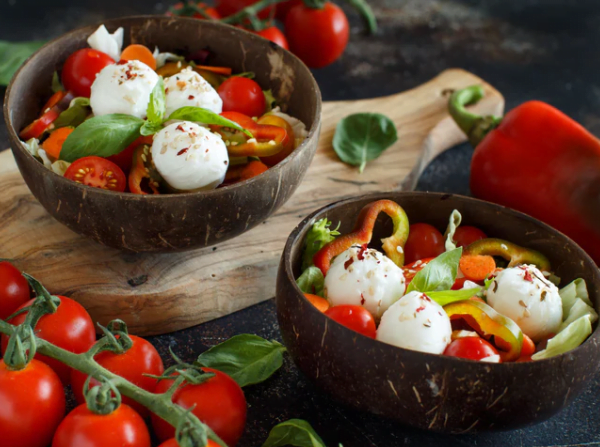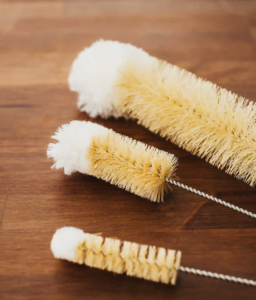- Handmade Upcycled Coconut Bowls
- How is this unique and 1 in a billion like you?
- How is this coconut bowl eco friendly?
- How is this handmade coconut bowl impacting the environment?
- What is the composition of this coconut bowl?
- What is the size of the coconut bowl?
- How this coconut bowl acts as a décor and enhances sustainability?
Handmade Upcycled Coconut Bowls
Indulge in the captivating allure of Bambaw’s artisanal coconut bowls, a manifestation of craftsmanship and sustainability originating from the idyllic landscapes of Bali, Indonesia. With meticulous care, each coconut shell is handpicked, its destiny transformed from nature’s bounty into a functional masterpiece. The selection process is an art in itself, as only the shells of the perfect size are chosen, ensuring that these bowls exude both elegance and practicality. The journey of these shells has just begun as they embark on their remarkable transformation.

A meticulously crafted process unfolds, culminating in the creation of coconut bowls that not only charm with their rustic beauty but also stand as a testament to thoughtful design. Through skilful hands, these bowls acquire a flattened base, offering unwavering stability to grace your tabletop. But the journey doesn’t stop there – a final touch of brilliance emerges as each bowl is lovingly polished with nourishing coconut oil.
This not only enhances their innate splendour but also renders them dishwasher safe, effortlessly blending convenience with sophistication. Bambaw’s coconut bowls are more than just culinary vessels; they encapsulate the harmonious blend of nature’s gifts and human ingenuity, enriching your dining experience while treading lightly on the planet’s resources.
How is this unique and 1 in a billion like you?
Absolutely, coconut shells exhibit inherent individuality. Influenced by factors like the type of coconut, tree, and growth conditions, each shell bears unique attributes. Variances in size, shape, colour, texture, and even thickness set them apart. These distinctions stem from the organic growth process, resulting in shells that narrate their own stories. Craftsmen harness these differences to create one-of-a-kind pieces like Bambaw’s coconut bowls, each celebrating the distinct charm of the shell it originated from. As nature’s artistic canvases, coconut shells stand testament to the beauty born from diversity.
Coconut shells, while seemingly commonplace in tropical environments, possess an inherent uniqueness that sets them apart as truly one in a billion. Amidst the vast array of natural materials, each individual coconut shell possesses distinctive qualities and characteristics that make it a singular entity. Hence, these coconut shells, like you are unique.
How is this coconut bowl eco friendly?
An upcycled coconut bowl is a prime example of innovative sustainability, taking what might have been discarded and transforming it into a functional and visually appealing object. These bowls are created by repurposing discarded coconut shells that might otherwise go to waste. Through skilled craftsmanship, artisans clean, shape, and refine these shells, turning them into unique and eye-catching bowls that can serve a multitude of purposes. From a simple decorative piece to a practical serving vessel, upcycled coconut bowls embody the ethos of reducing waste while embracing creativity. These bowls not only showcase nature’s beauty but also reflect our ability to reimagine and give new life to materials that were once considered disposable.
An upcycled coconut bowl is eco-friendly for several reasons:
1 Waste Reduction: The primary environmental benefit of upcycling is waste reduction. By repurposing discarded coconut shells that would otherwise end up in landfills or incinerators, upcycled coconut bowls help divert waste from these disposal methods.
2 Resource Conservation: Upcycling minimizes the need for new raw materials. By using existing coconut shells, the demand for additional resources, such as plastics or metals, is reduced, leading to lower energy consumption and fewer natural resources being extracted.
3 Energy Efficiency: Creating products from upcycled materials typically requires less energy compared to producing items from scratch. The processing and manufacturing steps are often simpler, leading to reduced carbon emissions and energy use.
4 Chemical Minimization: Upcycled products often involve fewer or no harmful chemicals compared to new production processes, contributing to a healthier environment.
5 Encourages Circular Economy: Upcycling is a key principle of the circular economy, which promotes the continuous use and reuse of materials. It extends the lifespan of materials and products, reducing the need for constant production and disposal.
6 Promotes Creativity: Upcycling encourages innovative thinking and creativity, showcasing that discarded items can be transformed into valuable and functional items.
7 Supports Sustainable Practices: Choosing upcycled products supports environmentally conscious practices and businesses that prioritize waste reduction and resource conservation.
How is this handmade coconut bowl impacting the environment?
In the process of producing coconut oil, a significant by-product arises in the form of coconut shells. However, a prevalent but unsustainable practice has been to openly burn these shells. This approach poses several environmental concerns, primarily due to the release of substantial amounts of unnecessary CO2 and methane emissions. This not only contributes to air pollution but also exacerbates the greenhouse gas effect, further impacting climate change. A more ecologically sound alternative exists, involving the transformation of these discarded coconut shells into valuable products.
The exceptional suitability of coconut shells for upcycling stems from their inherent properties. When carefully crafted, these shells can be reshaped into sturdy and durable natural coconut bowls. The material’s abundant availability ensures a steady source, while its compostable nature aligns with sustainable practices. However, despite these potential benefits, the sheer volume of coconut oil production often leads producers to opt for the seemingly convenient approach of open burning. This practice, while providing a quick and cost-effective disposal method, disregards the broader ecological implications and the potential for creating valuable goods from these shells.
Shifting away from the practice of open burning presents an opportunity to harness the full potential of coconut shells. By embracing upcycling techniques and transforming these shells into functional items like coconut bowls, producers can align their operations with environmentally responsible practices. This transition not only curbs emissions but also presents a way to reduce waste, promote resource efficiency, and contribute positively to the circular economy. Recognizing the value of every element in the production process, including coconut shells, is a pivotal step toward achieving a more sustainable and harmonious relationship with our environment.
What is the composition of this coconut bowl?
The handmade coconut bowls are made of coconut shells and coconut oil.

Crafted from authentic coconut shells, our coconut bowls embody the essence of nature’s beauty. Handpicked by farmers, these shells undergo a meticulous transformation. Through skilled shaping and sculpting, they take on the form of functional art. To ensure a smooth and lustrous finish, each shell is carefully polished both inside and out, enhancing its aesthetic appeal and eliminating any splinter concerns. The entire process is a testament to the artistry of handmade craftsmanship, ensuring that every bowl is utterly unique, carrying its own distinct character and charm.
In order to ensure waterproof resilience and long-lasting preservation, the coconut shells are meticulously treated with a coating of nourishing coconut oil.

The coconut bowl comes in two different forms. You can either choose the polished one or a raw one. The above picture is of the raw version of the product.
What is the size of the coconut bowl?
Each coconut bowl exudes individuality, boasting distinctive variations in size, shape, and color that showcase the inherent charm of natural materials. Despite their unique attributes, a unifying thread runs through these creations – each bowl maintains a diameter ranging from 12 to 15 cm, accompanied by a height of 5 to 6 cm. This consistency in dimensions ensures that while each bowl stands as a unique work of art, they all share a harmonious and functional design foundation.
How this coconut bowl acts as a décor and enhances sustainability?

Elevate your dining experience with handmade coconut bowls that offer versatile functionality and artistic flair. These bowls serve as captivating vessels for nourishing breakfast smoothie bowls, vibrant salads, hearty soups, or delectable snacks. Embrace their eco-friendly charm as decorative accents, enhancing your space with a touch of rustic elegance. Ideal for hosting gatherings, they create an eye-catching centrepiece or unique serving dishes. With these artisanal coconut bowls, you invite sustainability and creativity into your daily rituals, fostering a mindful connection with nature’s beauty.
Savour the essence of sustainability as you relish your delectable recipes in the embrace of a natural coconut shell. Crafted through an innovative upcycling process from discarded coconut shells, this exquisite handmade bowl not only elevates your dining experience but also champions the environment. With its eco-friendly origin and inherent charm, this bowl becomes the perfect companion for indulging in wholesome and nourishing meals. As you enjoy your culinary creations, remember that this handmade coconut bowl carries a story of renewal and conscious choices, making every bite not only satisfying but also a testament to responsible living.



[…] about the handmade coconut bowl to help your kitchen transform to be more natural and close to earth […]